
| ||||||||||||||||||||||||||||||||||||||||||
| A Bedouin (nomadic Arab) family | ||||||||||||||||||||||||||||||||||||||||||
| Total population | ||||||||||||||||||||||||||||||||||||||||||
|---|---|---|---|---|---|---|---|---|---|---|---|---|---|---|---|---|---|---|---|---|---|---|---|---|---|---|---|---|---|---|---|---|---|---|---|---|---|---|---|---|---|---|
| approx. 422,000,000[1] (Including 25-30 million Arabized Berber people)[2] | ||||||||||||||||||||||||||||||||||||||||||
| Regions with significant populations | ||||||||||||||||||||||||||||||||||||||||||
| ||||||||||||||||||||||||||||||||||||||||||
| Languages | ||||||||||||||||||||||||||||||||||||||||||
|
Vernacular: | ||||||||||||||||||||||||||||||||||||||||||
| Religion | ||||||||||||||||||||||||||||||||||||||||||
| Related ethnic groups | ||||||||||||||||||||||||||||||||||||||||||
|
Jews, Assyrians, Canaanites, Samaritans, other Semitic peoples |
The Arab people (Arabic: الشعب العربي ash-sha'b al-Arab) and Arabians (Arabic: عرب al-Arab) and "Arabic people" are a Semitic ethnic group that is indigenous to the Arabian Peninsula in West Asia with a large pan-ethnic "Arabized" population in the Levant, the Fertile Crescent and North Africa.
The Arab people are heterogeneous, coming from different ethnic and ancestral origins. What binds the Arabs together is that they are unified by the Arabic language, those who speak Arabic as a native language. This region is what the world calls the Arab World, which is a collection of 22 countries that designate Arabic as an official language. These 22 countries form the political entity known as the Arab League.
Etymology[]
- Muslim historians claim that the term Arab was coined for descendants of Yarab (Arabic: يارب), a poet and linguist from the modern-day country of Yemen who is credited for speaking the earliest Arabic dialect and creating some written form of it.
- Another likely origin is from an Akkadian context during the Assyrian conquest of Syria in 9 B.C. which describes them as "Gi-in-di-bu'u ar-ba-a-a" which translates into "the man belonging to the Arab"
- The term Arabia originated from the Greek term Aravia which was the name given to the desert-regions of the Middle East, including Egypt. The Romans later changed it to Arabia which was given to the ethnic Arab provinces of the Roman Empire, mostly the Syrian Desert
- According to Al-Masuda, an Arab Muslim historian from the Middle Ages, the term Arab came from Ishmael's tribes that resided in the Jordanian-Israeli region of Arabah. There was also a region near Israel which came to be known as the "Arabu" tribes according to some Biblical maps.
- In Biblical terminology, the term Arab (Hebrew: ערבי Arvi) describes the desert origins of Bedouins, in Hebrew Arava means wilderness (Hebrew: ערבה) another possible is erev (Hebrew: ערב) meaning "mixed" since Midian and Ishmael (thought to be ancestors of certain Arabs) were of mixed Hebrew bloodline (through Abraham) and foreign descent through their mothers
History[]
Early History & Ancestry[]
The geneology of the Arab people is more-often recorded in archeological findings as well as in religious texts, mostly that of Abrahamic religions. Ancient graffiti of spoken Proto-Arabic dialects can be found throughout caves the southern Arabian Peninsula that date back as early as 9 B.C.[15] The Arabs were known to be the native nomads inhabiting the Arabian Peninsula and the Syrian and Iraqi deserts. The Arab World is diverse in origin and are classified by Arab and Muslim scholars into two types: Adnani Arabs and Qahtani Arabs.
Northern Adnani Arabs[]
The Adnani Arabs are also known as "Arabized Arabs" or "Adnanites". These Arabs, who inhabited the central and northern parts of the Arabian Peninsula, believe themselves to be descendants of the Biblical patriarch Abraham which Islamic scriptures call Ibrahim (Arabic: إبراهيم), a prophet in Islam. They come from
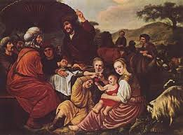
Moses takes his leave of Jethro by Jan Victors, c. 1635, from the incident in Exodus 4:18. Jethro is seated on the left, in red
Ishmael (Hebrew: הָגָר Yishma'el, Arabic: إسماعيل ʾIsmāʿīl), Abraham's first-born illegitimate son who he gave birth to with Hagar (Hebrew: הָגָר), his Egyptian slave and concubine. After an altercation with his younger half-brother, Isaac, he and his mother were expelled to the desert after a request by Abraham's wife Sarah who was a Hebrew. Ishmael had twelve sons, who settled in northern and central Arabia. Their descendants became known in the Bible as Ishmaelites (Hebrew: בני ישמעאל Bnai Yishma'el). According to Islam, Ishmael adopted Arab culture after arriving in Mecca and marrying a native from Yemen. The name "Adnani" origins from Adnan (Arabic: عدنان), which according to Islamic sources was a descendant of Ishmael and the father of the Ishmaelites that settled in the Arabian Peninsula. The Islamic prophet Muhammad is believed to have been an Adnani Arab. The Adnani Arabs often had a history of boasting and bragging about their alleged descent from Abraham. Abraham also had another concubine, named Keturah and they gave birth to Midian, who is also believed to have been an ancestor of Arabs. They were known in the Bible as Midianites (Hebrew: בני מדין Bnai Midian).
Southern Qahtani Arabs[]
The Qahtani Arabs, or the "Qahtanites" are known as the "pure Arabs" who inhabited the southern Arabian Peninsula where modern-day Yemen and Oman are located. They were believed to be descended from Joktan (Hebrew: יָקְטָן) who is known as Qahṭān (Arabic: قحطان) in Arabic-sources, who is a descendant of the Biblical patriarch Noah through his son Shem. The Qahtani tribes often struggled against their Adnaniite counterparts, especially for Qahtanite minorities living amongst Adnanite majorites in Arabia. The Adnanites often saw having Abraham's descent as a symbol of supremacy and ethno-centrism, often using it against the Qahtani people.
Other Arabs[]
Despite the presence of Arab tribes in Syria as early as 9 B.C., most of the Arabs outside of Arabia (North Africa, Horn of Africa and Fertile Crescent) are "Arabized", people or musta'arab (Arabic: المعربة), meaning they are descended from native non-Arab tribes that settled the region which also applies to the off-spring of Abraham and his concubines. The North Africans are descended from native ancient Egyptians, Cushites and Berbers that populated the area. The people of Iraq are descended from ancient Mesopatamians and those from Syria and Lebanon mostly contains Aramean and Phoenician origin.
Relationship with other ancient kingdoms []
The Arabs had significant interaction with other regional powers of the time, having war with some and maintaining alliance with others. As far as 9 B.C., the Arabs in the Syrian Desert were at war with the Assyrian Empire, and were eventually conquered. In Biblical sources, geographical places are often noted by a patrilineal ancestor. Midianites and Ishmaelites settled in the Arabian Peninsula. Furthermore, the Land of Midian (Hebrew: ארץ מדין)
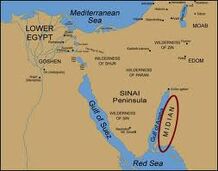
Location of Midianite lands
was located in what is modern-day Saudi Arabia. In Exodus 18, Moses meets a Midianite priest by the name of Jethro (Hebrew: יתרו) who previously in Exodus 2:18 is known as Reuel (Hebrew: רעואל) and Shu'ayb (Arabic: شعيب) in Islamic sources. Jethro gives his daughter, Zipporah (Hebrew: ציפורה) to marry Moses and they gave birth to a child named Gershom. Although most of the Bible refers to Zipporah as being Midianite, through her descent from Jethro, Numbers 12:1 gives a controversial reference to her as a "Cushite".
According to Genesis 26:35, Esau, the first-born son of Isaac marries a daughter of Ishmael. It is unknown of any curse on Ishmael's descendants, but despite being born of Israelite origin Esau was considered a disgrace to the Israelite community in the Bible since he sold his birthright for a bowl of lentils and often intermingled with cursed races such as the Hittites.
The Arabs had become involved in heavy trade with the Kingdom of Israel during the reign of king Solomon and with the the Kingdom Judah (the southern splinter Hebrew kingdom south of Israel) under the reign of Jehoshapat. Among the things that Arab traders brought to Israel and Judah were gold, spices, goats and rams.
In 2 Chronicles 2:14 it reads, "Beside that which chapmen and merchants brought. And all the kings of Arabia and governors of the country brought gold and silver to Solomon."
In 1 Kings 10:14-15 it reads, "Now the weight of gold which came in to Solomon in one year was 666 talents of gold, besides that from the traders and the wares of the merchants and all the kings of Arabia and the governors of the country."
However, periods of large-scale hostility also existed between the Arabs and the Israelites. In many of these cases, the Arabs were collaborating with Israel's enemies - such the Philistines and the Persians. According to 2 Chronicles 22:1, Ahaziah, the youngest son of Jehoram became King of Israel since all of the elder brothers were slain by bands of raiders that included Arabs. One of the enemies of Nehemiah, the Jewish leader under Persian rule, Geshem was a tribal leader from Arabia who strongly opposed, mocked and ridiculed Nehemiah's attempt to rebuild the temple in Jerusalem since he saw it as an act of rebellion against the Persian king. Geshem is the only figure in the Bible that is specifically referred to as an "Arab", or Geshem the Arabian (Hebrew: גשם הערבי). it is suggested that the Arabs were a Persian vassal at the time. Arab existance in ancient Persian territory was common during the Achaemenid rule.
Nehemiah 2:19 reads, "But when Sanballat the Horonite, and Tobiah the servant, the Ammonite, and Geshem the Arabian, heard it, they laughed us to scorn, and despised us, and said, What is this thing that ye do? will ye rebel against the king".
According to Numbers and several other Biblical books, the Israelites under the leadership of King David went to a large and bloody war against the Midianites since they tried to sneer the Israelites into Pagan worship. By this time, it is suggested that Arabs had become Pagans.
Kingdoms in South Arabia[]

An ancient griffin found in Yemen
The southern Arabian Peninsula is known as the homeland of the true and the pure Arabs, were most of the ancient attested kingdoms and civilizations existed. They are also known for adopting monotheistic religions such as Judaism and Rahmanism while as their attested state religions while Paganism also existed.[16] Many of them reflected Greek and Latin influence, such as the worshipping of the Griffin, a legendary creature as a result of Roman influence. These ancient Arab states became subject to invasion attempts from the Romans. Aelius Gallus, the Roman governer of occupied-Egypt had tried to conquer the city of Najran but failed to. The Romans later referred to southern Arabia as "Arabia Felix" which means "Happy Arabia" in Old Latin. Among the predominant kingdoms were Himyar, Saba and Qataban.
Himyarite Kingdom 110-525 A.D.[]

Map of the South Arabian kingdoms and the African kingdom of Aksum
The Kingdom of Himyar (Arabic: مملكة حِمْيَر) became the main dominant polity in South Arabia, specifically in what is today southern Yemen.[17] It was found by a clan of Qahtani Arabs known as the Himyarites (Arabic: بنو حمير) or Homerites according to Greek accounts. The Himyarites' capital was based in the city of Zafar and then to the modern-day city of Sana'a.[18] A center of economic power, Himyar was used as a crossing by foreign traders, linking the civilizations in East Africa to those of the Mediterranean nations. The Himyarites exported frankincense and myrrh, which created the majority of their economic monopoly. The Himyarite kingdom is also significant to the history of Judaism, as many of its kings and leaders were known to be sadistic converts to Judaism.[19] Because of the iron-fist nature of the Himyarite rulers, the Himyarites were able to conquer the other civilizations in the southern Arabian Peninsula. The Himyarites met their fell when their last king, Yūsuf Dhū Nuwās (Arabic: يوسف ذو نواس) decided to attack the Christian community in Najran, which was a territory of the East African Axumite kingdom as part of his war against them. The Axumite king eventually retaliated, conquering Himyar and deposing Dhū Nuwās. Yemenite Jews are the descendants of these ancient South Arabian Jews, but do not consider themselves to be Arabs due to their belief that they descendants of Israelites in Yemen rather native Arab converts to Judaism.
Kingdom of Saba/Sheba []
Another significant south Arabian civilization was the Kingdom of Saba (Arabic: سابا) which is highly thought to have been the kingdom known as Sheba (Hebrew: שיבא) in Old Testament accounts whom the Himyarites later conquered after capturing the modern-day city of Najran in Saudi Arabia today. It was ruled by a powerful historical queen of an unknown name, who is commonly referred to as the Queen of Sheba (Hebrew: מלכת שבא) or Queen of the South in
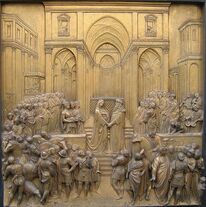
Renaissance relief of the Queen of Sheba meeting Solomon - gate of Florence Baptistry
Biblical sources, Makeda (Amharic: ማክዳ) in Ethiopian accounts and Bilquis (Arabic: بلقيس) in Arabic and Islamic sources. She established diplomatic relations with the Israelites after meeting with King Solomon, whom Ethiopians believe she actually married as they claim to be offspring of both. The Queen of Sheba's ancestry is in debate among historians, who either point out to a native South Arabian or an East African monarch. Yemeni and Ethiopian sources provide conflicting views as to where her kingdom was located. Arabs believe Sheba was in Yemen and Ethiopians believe it was in Adis Ababa, Ethiopia's capital. The Sabians (Arabic: الصابئة), a distinct ethno-religious group mentioned in Islamic and Jewish accounts are assumed and denied by others to be descendants of the Sabaean kingdom.
Nabataean Kingdom 168 B.C.-106 A.D.[]
The marvelling Nabataean kingdom was found in 168 B.C. The term refers to the region of Nabatene, in a region of the Levant between
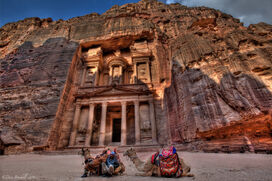
The ancient city of Petra
Arabia and Israel. Some theorize the name derives from Nebaioth (Hebrew: נְבָיוֹת), the first-born son of Ishmael. The Nabataeans were descended from an extinct Arabian people known as the Thamud (Arabic: ثمود), and also mixed with in with other Arab migrants as well as local Arameans. The Nabataeans' main center of trade and commerce was focused around the city of Petra in Jordan which became a flourishing trade center and considered the "middle" of the Middle East. The Nabataean kingdom spanned all the way from Jordan and Syria and southern Israel to Madeh in'Saleh in Saudi Arabia.[20] The Nabataeans used a distinct style to build their temples - which was the art of "carving" their buildings into the natural sandstones of the deserts.[21] Although originally an Aramaic-speaking civilization of mixed Arab and Aramean descent, the Nabataeans gradually adopted Arabic as their main language and eventually displaced Aramaic. The Nabataeans were also among the earliest to offer a written standard form of spoken Arabic which came from the cursive variant of their alphabet. The Nabataeans were later conquered by the Romans under the lead of the Emperor Trajan, who then established it as a Roman state. According to Islamic sources, the Thamud disappeared because of their disobedience to God.
Arabs Under Roman and Byzantine Rule and Influence[]
As Christianity grew in the Middle East, many Arab communities adopted to the new Abrahamic faith. Extensive trade, contact and even conquest allowed many Arab clans to establish strong pacts with the Byzantines, Greeks and the Romans from Europe. Regions with Arab tribes were also annexed by the powerful Roman Empire, which had already been a melting pot of ethnic states, united by Pagan and later, the Catholic religion with Latin as its lingua
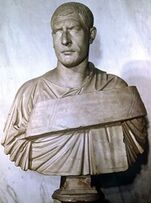
Head-bust of Philip the Arabian, 33rd Emperor of the Roman Empire
franca. The Arabs later absorbed the Latin and Greek influence as a result. Syria was annexed by the Romans as Arabia Petraea and thus, Syrians were referred to as Arabians or Arabs, which mostly applied to those of the Syrian deserts. Most of them were descendants of migrants from Yemen. These Arabs had established a well-known presence in Roman politics, almost all of them were Arabs from the Syrian Desert. They were common in the Severan Dynasty of the Roman Empire, such as Julia Domna the wife of Roman emperor Lucius Septimus, and Elegabalus, who was Roman emperor from 218 to 222 and a descendant of Domna. Both Domna and Elegabalus were natives of what is today the city of Homs in Syria. In 244 A.D., Marcus Julius Phillippus, or as he was famously known, "Philip the Arab" (Latin: Philippus Arabus) became Roman emperor. Philip the Arab pursued a policy of making peace with the Persian Sassanid Empire. It is also claimed that Philip the Arab became an early Christian convert as he showed sympathy towards Roman Christians. His alleged conversion to Christianity is however, speculative. Philip the Arab was a native of modern-day Shahba in Syria.
Ghassanid and Lakhmid Confederations[]
The Arab civilization known as the Ghassanids began approximately around 220 A.D. It was found by Jafnah I ibn 'Amr, leader of a tribe known as the Banu Ghassan (Arabic: بني غسان). He emigrated with his family to Syria. Originally pagans from what is today Yemen, the Ghassanids eventually adopted Christianity when they settled in the Levant. It is agreed by many historians that Philip the Arab was of Ghassanid origin from Yemen. The Byzantine Empire used the Ghassanids to protect itself from Bedouin invaders as well as foreign threats. Similarly in 268, sheikh 'Amr I ibn Adi who was the leader of a tribe known as the Banu Lakhm (Arabic: بنو لخم) settled in what is now southern Iraq and established the Lahkmid confederation; which lasted from around 268-638. Upon settling in Iraq, the Lakhmids also adopted Christianity, however they adopted a different form and became a vassal of the Persian Sassanids and established Al-Hira (Arabic: آل حراء) in Iraq as their capital.[22] The Ghassanids and Lakhmids eventually found themselves at war with one another. This occured for two major reasons. The Ghassanids and Lakhmids followed sections of Christianity that had conflicting beliefs. Also, the Persian Sassanids were an enemy of the Byzantine Empire.
The Palmyrene Empire[]
In 260 A.D., a queen from Syria known by the name Zenobia led a revolt against the Roman rulers of Syria. Zenobia successfuly freed Syria of Roman rule and expanded her kingdom to Asia Minor, Palestine and Egypt, which historians refer to as the Palmyrene Empire, after its capital Palmyra.[23] Zenobia was also successful in pursuing her father's assassin and leading his execution, impacting the role of women as powerul rulers. Like the Queen of Sheba, Zenobia's ancestry is in some debate among historians, pointing to several possible ethnic origins such as Arab, Jewish and Aramean, surely she was of Semitic origin. She did name her son Wahb Allat which means "gift of the goddess" in Arabic and is commonly translated as Vaballathus in Latin She did come from a family of Aramaic-naming customs, which was a common practice among many Arab communities at the time. She is known as Bat-Zabbai (Aramaic: 'בת זבי) in Aramaic sources and Al-Zabba (Arabic: الزباء) or Zainab (Arabic: زينب) in Arabic-language sources. Al-Tabari, a Persian historian, claims that Zenobia came from a tribe known as the Amlaqi, where her father was its sheikh. Her father's Latin name was Julius Aurelius Zenobius, and 'Amr ibn al-Zarib in Arabic, according to Al-Tabari.
Dawn and Spread of Islam 600 A.D.[]
In the seventh century, a religious leader by the name of Muhammad from the Banu Quraish (Arabic: بني قريش) in the city of Medina in Arabia, began his ministry, founding a new monotheistic and Abrahamic religion he referred to as Islam. His teachings contained many elements from the previous monotheistic religions Christianity and Judaism, proclaiming himself as the final and "greatest" prophet of God's "chosen" line of messengers - which of
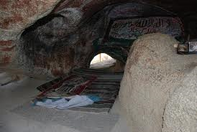
The ancient cave in Jabal al-Nour in Saudi Arabia where Muhammad allegedly saw Angel Gabriel
many being same figures from the Bible like Moses, Abraham and Jesus. Only that Islam regards Jesus as a lesser being, a prophet, and not the son of God. Although Ishmael and Isaac are both regarded as prophets in Islam and both covenant heirs of Abraham, Muslims believe Ishmael to be the greater chosen above Isaac and believed that it was Ishmael who Abraham nearly sacrificed instead. Muslims also believe that the Arabic language was the chosen language of divinity, and not Hebrew. Through Muhammad's relatives and descendants, Islam experienced a rapid expansion through the Middle East, including the areas where Christianity and Judaism had already existed such as the Fertile Crescent and the Levant and dominated the Arabian Peninsula giving Islam its dominant role in Arab culture today. Mecca and Medina were converted to Islamic holy sites, after the defeat of the Pagan Meccan armies by the army of new converts. According to Islamic context, the prophet Muhammad ascended to Heaven from the Temple Mount in Jerusalem. It is this visit that made Jerusalem the third most holiest city in Islam.
Rise of Islamic Caliphates and Sultanates[]
The rapid expansion of Islam gave rise to massive kingdoms under Islamic jurisdiction. Those of Muhammad's family, ruled kingdoms known as caliphates, a caliph (Arabic: خليفة) is a relative or descendant of Muhammad and also a leader of Islam. In 661 A.D., the Umayyad caliphs gained power in the Middle East and conquered the city of Damascus, establishing it as the capital of the Muslim World and of Sunni Islam. The Umayyad Caliphate (661-750) covered land spanning from West Asia, North Africa and Israel to the entire Iberian Peninsula and Persia. Umayyad ruler Abd-al-Malik also ordered the construction of a shrine on Jerusalem's Temple Mount that marks where the Islamic prophet Muhammad ascended. Following the fall and overthrow of the Umayyads came the Abbasid Caliphate, which established the new Muslim capital to Baghdad in Iraq and was also marked by the rise of Shia Islam. The Abbasid rule was marked by an era historians come to know as the Islamic Golden Age, an uprising in Islamic culture with the fushion of Arab, Persian and Indian cultures. The Abbasids experienced a reinassance in astrology, medicine, mathematics and philosaphy. After the Abbasids fell, the Fatimids became the new caliphs where the Druze faith was founded.
Conquest of Europe[]
In 711 AD, a group of Umayyad exiles from North Africa invaded the neighboring Iberian Peninsula (now Spain and Portugal) in the north in Europe under the lead of Tariq ibn Ziyad, a general
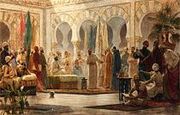
"Abd-ar-Rahman III and his court in Medina Azahara", by Dionisio Baixeras Verdaguer.
from North Africa. They battled with a Germanic Christian kingdom known as the Visigoths, that had already ruled the Iberian Peninsula prior, and defeated them. The Muslim-controlled regions of the Iberian Peninsula were known as Al-Andalus, and the ruling powers varied between the dynasties from West Asia and North Africa such as the Arab-dominated Umayyads or the Berber Almohades and Almoravids. The most powerful Muslim states based their capitals in today's Spanish cities of Córdoba and Granada. Abd-ar-Rahman III, an Umayyad-Spanish prince led the most powerful rule from Córdoba, as a caliph of the Islamic World for ever half a century. Under his reign, people of many religions and ethnicities enjoyed tolerance in his kingdom, it became home to a large Jewish population that also went through a golden age. The Muslim rule in Spain saw the construction of beautiful mosques, palaces and fortresses, such as the Alhambra Palace in Granada, then, then a sultanate, which is a Muslim state ruled by a sultan (Arabic: سلطان). The Muslims were known as Moros or Moors. Other European places that that Muslims conquered include Italy (Sicily), Malta and Greece (Crete). The conquest of Europe would lead to a tenure of centuries-long armed struggles between the Muslim and Christian armies in the Middle Ages, what historians refer to as The Crusades.
The Reconquista & Expulsion of from Europe[]
The Muslim rule in Spain had no unity, which resulted in civil wars and disputes over heirs and successors. This weakened the Muslim and Arab rule in Europe, setting the stage for the Christian reconquering of Europe. The Spanish, French, Italian, Greek and other Christian armies used this as an oppurtunity to
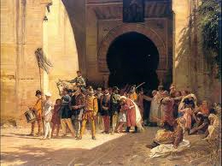
An artist's rendering of the Morisco expulsion
regain control of Europe and re-Christianize it, the most dramatic battle took place in the Iberian Peninsula, known as the Reconquista. Muhammad XII, the last sultan in Al-Andalus, surrendered upon surrounding by European armies. After the Arab and Muslim armies lost control of Spain, King Philip II made treaties with them allowing them to practice their religion if they gave up their sovereignty, signing the Treaty of Granada in 1491. The Catholic monarchs however, aborgated the treaties and threatened to expel the Moors if they did not become Christians. The Moors did so, but continued speaking Arabic, writing the Spanish language in the Arabic alphabet and followed Muslim culture. Some even followed Islam in secret (Crypto-Islam). They were later referred to as Moriscos, Moors and their descendants who converted to Christianity rather than be expelled. Religious conversion was simply not enough for the Catholic monarchs. Phillip II then began a pogrom to fully assimilate the Moriscos into the Christian Spanish population and eliminate Moorish and Arab culture from Spain. The Moriscos were forced to abandon their Arabic names and adopt a completely Hispanized heritage and give up their children to be educated by priests. Philip II also made speaking Arabic illegal in the kingdom, ordered all Arabic texts to be burned and banned Moorish attire. After a failed revolt by Morisco leader Aben Humeya (or Ibn Umayyah) in 1568, the Christian monarchs expelled the Moriscos from Spain. Many of these Moriscos headed for North Africa, mainly in Morocco where many of their descendants settle.
Ottoman Conquest[]
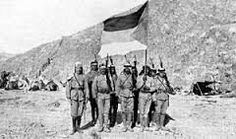
Arab freedom fighters
In the fifteenth century A.D., the Ottomans conquered North Africa and the Levant and were part of the Muslim armies that fought the European Christian armies during the Crusades. In 1916, a Meccan emir (another Arabic and Islamic royal title) by the name of Hussein bin Ali (Arabic: حسین بن علی) initiated the Arab Revolt against the Ottomans. In 1924, the Ottoman Empire was finally dissoluted although its last sultan renounced his power two years prior in 1922. Afterwards, Ali proclaimed authority over all Muslims and found the Kingdom of Hejaz which neighbored the Sultanate of Nejd. His son, Faisal I became the king of Iraq and unified Syria and the Hejaz. The Kingdom of Hejaz and Nejd were unified when Arabia came under of the rule of Abdulaziz Bin Saud (Arabic: سعود بن عبد العزيز) in 1932, he renamed the merged kingdoms to "Saudi Arabia" - after his family and established the Kingdom of Saudi Arabia which would become one of the most economically powerful nations in the Middle East. The region of Palestine fell from Ottoman control, to British control and became known as Mandatory Palestine with Arabic, Hebrew and English as the spoken languages of the region.
Cold War Era[]
In 1948, Britain's hold of Mandatory Palestine expired and was replaced with a Zionist (Jewish nationalist) state, which brought an angry opposition from the Arab World that culminated into a devastating and on-going tenure of armed conflict between Israel and the Arab states, involving both state armies and militant groups. Most battles ended up in an Israeli victory or a draw. The Al-Nahda (Arabic: النهضة) was a period of Arab literary reinassance. Known as "The Awakening", it was brought into attention by prominent Pan-Arab authors, sociologists and poets such as Michel Aflaq from Syria and Emile Habibi of Israel, most were Arab Christians. Egypt's second president, Gamal Abdel-Nasser became a symbol and leader of Arab politics. It is Abdel-Nasser who eliminated imperialism in Egypt and Sudan, bringing modernization to the Egyptians and tried to stabalize conditions in the Arab World. During the Cold War, many Arab leaders adopted secularism and secularist ideaologies.
Arab-Israeli Military Conflict 1948-1973[]
In 1948, the Arab Legion and Jewish paramilitary groups fought a war in Palestine, which ended in a Jewish victory and the creation of the State of Israel. This had begun the Arab struggle against Israel, as the surrounding Arab nations, most specifically Egypt and Syria declared war on Israel. Egypt and Syria fought four main wars with Israel, in 1948, 1956, 1967 and 1973 - mostly over the Suez Canal, Golan Heights and Mount Sinai. In 1956, the Egyptians and Israelis fought over the Suez Canal and while it ended in a tactical Israeli victory, the Israelis withdrew due to foreign pressure. In 1958, Egypt and Syria united and formed the United Arab Republic (Arabic: الجمهورية العربية المتحدة). In 1964, the Palestinian Liberation Organization (Arabic: منظمة التحرير الفلسطينية) was formed, or the PLO which aimed at creating an independant State of Palestine. In 1967, the Egyptian army led by Abdel-Nasser and joined by an alliance with Syria and Jordan, lost a brutal fight against the Israeli army for control of the Sinai Peninsula,
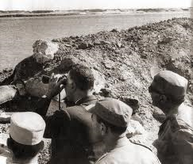
President Nasser of Egypt (with binoculars), surveys positions at the Suez Canal in November 1968
losing the territory. The loss had brought a humiliation in the Arab World. Afterwards, Abdel-Nasser initiated the War of Attrition (Arabic: حرب إستنزاف). Despite being supported by the Soviet Union, the Arab armies were unsuccessful against the Isrealis and the war didn't bring any significant changes. In 1973, Egyptian president Anwar el-Sadat and Syrian president Hafez al-Assad initiated the Yom Kippur War or the October War of 1973, which fell on the Islamic month of Ramadan and the Jewish holiday Yom Kippur. Under Sadat and Assad's leaderships, the joint Egyptian and Syrian forces would defeat the Israelis on the ea
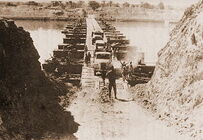
Egyptian forces crossing the Suez Canal on October 7,1973
rly stages of the war as the Arab forces broke through Israeli-held territory almost unchallenged and overunning Israeli forces stationed in the Sinai and Golan region. Although Israel would later repulse the invasion and win the war, the early victories gave the Arab World a propaganda victory, Egyptians and Syrians still celebrate the anniversary. It was also one of the first wars to force the Israeli army to rethink their defense strategies. The Egyptians owed much of their successs to the military leader Saad el-Shazly (Arabic: سعد الشاذلي). In 1978, Anwar el-Sadat signed the Camp David Accords with Israeli prime minister Menachim Begin; Egypt would become the first Arab state to recognize Israel. Thanks to Sadat, Mount Sinai was returned to Egypt after the signing of the Camp David Accords.
Modern Day Arab-Israeli Conflict 1973-now[]
Today, much of the Arab-Israeli conflict focuses on the fate of the Palestinian territories, as well as the involvment of Lebanon. Most of the modern-day conflict involves Palestinian and Lebanese militant groups and Israel, rather than state armies. When militant leader Yasser Arafat took leader of the PLO and found another militant group known as the Fatah (Arabic: فتح), he rose to prominence in the Arab World as a heroic freedom fighter, but brew much contrevoursy. He became the most wanted figure of the Israeli forces. In 1982, Lebanon was invaded by the Israeli army due to the presence of Palestinian militants located in the southern parts of the country, which ended up in an Israeli victory and the expulsion of Palestinian militants. In 2006, the presence of a well-trained Shia militant group known as the Hezbollah (Arabic: حزب الله) led the Israelis to invade Lebanon again due to attacks carried out by the Hezbollah. Unlike the other militant groups, the Hezbollah was able to inflict large-scale losses against the Israelis and end their feeling of military invincibility which led Israel to withdraw from the country later on. Military leaders of Israel also attributed to the Hezbollah as their counterpart, due to their distinct fighting style and effeciency. That led to a victory claim for Hezbollah, but the Israeli Air Force was able to destroy much of the Hezbollah's compounds and facilities which also led a claim towards an Israeli victory. Pro-Israel militants in Lebanon also fled the country as the Israelis withdrew and many of them settled in northern Israel in the predominantly Maronite Catholic-inhabited city of Jish (Arabic: الجش). In 2008, a Palestinian Sunni militant group known as the Hamas (Arabic: حماس) fought an unsuccessful war against the Israeli army who invaded the Gaza Strip (under Hamas control) as a retaliation for rockets fired into Israel by the Hamas. This was repeated in 2012 and 2014 with another Israeli invasion into Gaza.
Arab Spring 2011-present[]
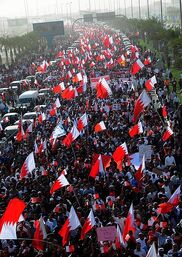
Over 100,000 of Bahrainis taking part in the "March of Loyalty to Martyrs", honoring political dissidents killed by security forces
In 2010-2011, a series of uprisings in the Arab World ousted several Arab leaders out of power and threatened security and order in the Arab World. Known as the Arab Spring (Arabic: الربيع العربي), the most violent and radical of these incidents ocurred and are ocurring in Egypt, Libya and Syria. Like many revolutions in Muslim nations, pan-Islamic ideals were a catalyst to these revolutions. They are mainly perpetuated by the Society of Muslim Brothers (Arabic: المجتمع من الإخوان مسلم) or commonly known by public media as the "Muslim Brotherhood" (Arabic: الإخوان مسلم), a radical Islamic organization from Egypt. Despite its claims of a "unified organization" of all Muslims, it is dominated and influenced by Sunnis and has led jihads against Shiites, non-Sunnis and non-Muslims. In 2011, Egyptian president Hosni Mubarak was removed from office and in 2013 the succeeding president Mohamad Morsi was removed from power. In Libya, Muammar al-Gaddafi (Arabic: معمر القذافي) who had been an influential Libyan politician, pan-Africanist and military leader was also ousted and killed in a violent and bloody protest. Currently in Syria, Sunni rebels are trying to overthrow president Bashar al-Assad who comes from a powerful Shiite-Alawite Muslim family and the son of Hafez al-Assad. Other Arab countries that experienced or are experiencing revolutions (violent or non-violent) are Tunisia, Oman, Algeria, Bahrain, Yemen, Sudan and Djibouti.
Language[]
Modern Arabic[]
The Arabic language belongs to the central Semitic family of the Afro-Asiatic languages, it is a world major language and is an official language in 27 countries, 22 of those nations are members of the Arab League (Arabic: جامعة الدول العربية). Despite the appearance of a standardized
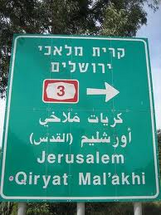
Arabic is one of Israel's two official langages
nature of Arabic, it is a decentralized and pluricentric language with many and countless numbers of regional dialects in the Middle East, North Africa and in the Horn of Africa. Standard Arabic is used a lingua franca between the Arab states, and used in Arabic-language media such as newpapers and television programming. Cypriot Maronite Arabic is a dialect is spoken in the tiny island nation of Cyprus by the Maronite Catholic communities in the predominantly-Greek Orthodox country and Greek-speaking nation. Arabic is also the official language of many Muslim organizations regardless of whether they are Arab or non-Arab, such as the Organisation of Islamic Cooperation which is the collective global voice of the Muslim world.
French, Spanish and Hebrew[]
As a result of the French occupation of North Africa and the Levant, many Arabs have retained their fluency in the French language, mostly North Africa and Lebanon. Many North African states have designate French as an official language alongside Arabic - and French is also an official language of the Organisation of Islamic Cooperation. Many Moroccans are also fluent in the Spanish language, as a result of the Spanish colonization of Morocco prior to French occupation. Arab citizens of Israel and Palestinians speak Modern Hebrew as a second language since it is the majority-spoken and an official language of Israel, alongside Arabic (second official). Like Arabic, Hebrew is also a Semitic language and Israel's Arab citizens incorporate many Hebrew words and phrases into their daily vernaculars. Hebrew was also spoken by the ancient Arabs, from those mentioned in the Bible (let alone being recorded with Hebrew names) and those in South Arabia.
Classical Arabic & Other Liturgical Languages[]
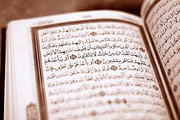
A page of Islam's holy book the Qur'an, all copies of this page are written in Classical Arabic
Arabic is also the liturgical language of Islam which is known as Classical Arabic (Arabic: اللغة العربية الفصحى), a direct descendant of Muhammad's native dialect. It has not changed up from Muhammad's time, unlike educational Arabic which has undergone many changes for modern-day use. Classical Arabic contains heavy influences from the Aramaic language, a northwestern Semitic language which was the liturgical language of Judeo-Christianity. Muslims are expected to read the Qur'an in Arabic rather than their own native languages, although they use translations in order to understand the meanings of phrases, all Islamic prayers, sermons and religious terminology are in Arabic. The Arab Christians do not use Classical Arabic, but rather Greek and Syriac, or Co
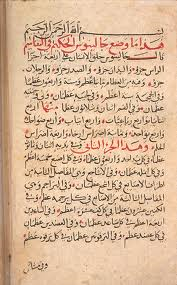
Medieval Arabic text
ptic in case of Egypt's Coptic Christians (self-considered non-Arab) - the last remnant of a living ancient Egyptian language.
Writing System []
Arabic contains its own native script, that was put into use by the Islamic prophet Muhammad and originated from a hybrid of Aramaic cursive and Syriac. It is known as the tanakh script (Arabic: النصي تناخ), all variants of the Arabic script are written horizantally from right to left. Some of the Modern South Arabian languages retain their alphabets, and others have become assimilated to their neighbors and are written in the Arabic script. A number of major alphabets have been used for the Arabic language and the Arabian dialects, including Syriac, Greek, and Hebrew, which was (after the advent of Islam) used extensively for the endangered Jewish dialect of Arabic known as Judeo-Arabic and some dialects still continue the use of these. The Maltese language is written in the Latin script, and is the only dialect of Arabic or any Semitic language that is written in the Latin script. The Cypriot Maronite dialect of Arabic is written in the Greek and Latin scripts, while some South Arabian languages in Yemen and Oman are still written in Syriac.
Religion[]
The Arab World is highly monotheistic, most Arabs are adherents to Islam with a large Christian and Druze minority living in the Levant and Egypt. Pockets of Arabic-speaking Jewish communities can also be found in Israel, New York City and France and Egypt and Syria are also home to many atheists and non-religious populations.
Islam[]
Most Arabs today follow Islam (Arabic: الإسلام), a monotheistic religion propagated by the Arabian prophet Muhammad whom adherents revere as God's last greatest prophet from a "line" of other messangers accepting the
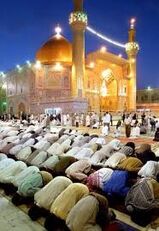
Shia Muslims performing salat prayers in Iraq near a shrine dedicated to the Shia prophet Ali
existing figures of Judaism and Christianity also as "prophets" or nabi (Arabic: انبیاء). Muslims worship Allah (Arabic: الله), which they deem and claim is the true name of the same God that Jews and Christians worship. In contrast to Biblical beliefs of Isaac and Ishmael, Muslims believe that Ishmael to be the promised heir of Abraham despite regarding both figures as part of the covenant. Followers of Islam are known as Muslims (Arabic: مسلم), many times also spelled as Moslem which according to Islamic definition is "one who submits", their preachers are known as an imam (Arabic: إمام). The holy book of Islam is known as the Qur'an (Arabic: القرآن), sometimes spelled as Koran with narratives of Muhammad's life which are known as the hadiths (Arabic: الحديث) which were written and recorded by Muhammad's relatives.
Religious Practices[]
Muslims worship in buildings known as mosques. The city of Mecca in Saudi
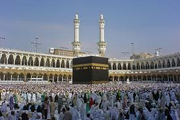
The shrine at Mecca
Arabia is the holiest city in Islam, each Muslim is expected to make a journey or a hajj (Arabic: الحج) to Mecca at least once in a lifetime. This is one out of the Five Pillars of Islam (Arabic: أركان الإسلام) which are five basic acts that each Muslim is obligated to do. The other four pillars include prayers or salats (Arabic: صلوات), confessions of faith known as the shahadah (Arabic: الشهادة), fasting during the holy month of Ramadan known as sawms (Arabic: صوم) and the zakat (Arabic: زكاة'l) which is the act of charity and giving alms.
Sections[]
The two main branches of Islam are the Sunni (Arabic: السنة الإسلام) and the Shia (Arabic: الإسلام الشيعي). Sunni Islam emerged during the Umayyad-era and contains the most adherants in the Arab World, and it sometimes known as Orthodox Islam. Followers of Shia Islam, are known as Shiites (Arabic: الشيعة), who believe that leadership is to remain only to Muhammad's relatives and descendants and has a historical affinity with Persians and former Persian territory. Another big difference is the rejection of the hadiths, which comes from Shia Islam.[24] Iraq (a former Persian state) is the only Arab nation that is a Shia Muslim nation by majority, most of the other Shiite nations are non-Arab nations which are the Persian-speaking countries of Iran and Afghanistan. Otherwise, religious and spiritual practices among Sunnis and Shiites do not differ by much. Islam is the world's second largest religion and growing at a rapid rate. It is the predominant religion practised in West Asia (Middle East), Central Asia, North Africa; and one of the predominant religions practised in Central Africa, Southeast Asia, South Asia (Indian Subcontinent), Southern Europe, China and Russia.
Christianity[]
Main Article: Arab Christians
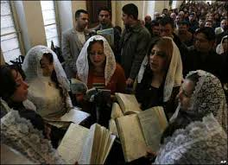
Palestinian Christians singing Biblical hymns
Christianity in the Arab World predates Islam, as a result of Byzantine, Roman annexation and Greek influence. Arab Christians are mixed descendants of Arabs that did not accept Islam or non-Arabs that adopted Arabic as a native language. Most Arab Christians are concentrated in the Levant, and follow historical Byzantine and Greek churches that operate in the Arab World, most are rooted from non-Arab upbringings such as the Maronite Catholic Church (Syriac: ܣܘܪܝܝܬܐ ܡܪܘܢܝܬܐ, Arabic: الكنيسة المارونية), native to Lebanon and Syria, and the Coptic Church which is a native section from Egypt. The Melkite Greek Catholic Church (Arabic: كنيسة الروم الملكيينالكاثوليك) is from Damascus in Syria, followers believe themselves to be the earliest group of Christians. Although considered Arab today, their ancestry is ethnically Greek or a mixture of both Greek and Arab.[25] Despite being native Arabic-speakers, many Christians (Copts and Maronites) have rejected the Arab panethnicity, in part due to the fact that both group are descended from non-Arab groups such as the Arameans and the Phoenicians and the native Egyptians for Copts.[26] There is also a large minority who follow the Roman Catholic Church. Roman
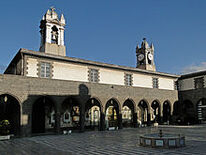
Melkite Greek Catholic Patriarchal Cathedral in Damascus
Catholicism is the majority religion practiced by the large Arab diaspora in Latin America and in Lebanon, one has to be a Maronite to be a president. Arabs are also predominant in the Christian clergy, such as, John of Damascus (Arabic: يوحنا الدمشقي) who was a founding father of eastern Christianity, and is canonized by many churches, both Roman Catholic or Greek Orthodox. Other than using distinct liturgical languages outside of Arabic, most Arab Christians follow a different form of traditions than their Muslim counterparts unless they be conservative of keeping their Arab culture strong, mostly Syrians and pan-Arab polymaths from Lebanon.
Other Religions[]
There is another distinct and syncretic branch of Shia Islam (Ismaili section) native to the Levant known as the Druze (Arabic: درزي), which is regarded as a seperate religion and ethnic community in Israel. The faith originated during the reign of the Fatimid caliph Al-Hakim bi-amr Allah Mas'ud and by Shiite Ismaili preacher, Muhammad ad-Darazi. Druze people are very dominant in Syrian history, and in Israeli politics and military as a non-Jewish group. Rather than Muhammad, they regard the ancient Midianite priest Jethro as the prophet of the Druze faith although Muhammad is an accepted prophet in the Druze faith and Jethro is considered a prophet in mainstream
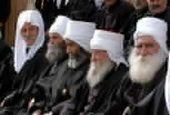
Druze men in Israel
Islam as well. Although they are a native Arabic-speaking group in Israel, the Israeli Druze often dissociate themselves from all the other Israeli Arabs and reject Arab and Palestinian nationalism. Unlike mainstream Islam, the Druze faith does not accept converts either.[27] There is an even smaller acclaimed population practicing Judaism who is a contrevoursy among historians, ethnographers, religious scholars and those who consider themselves to be Arab Jews (Arabic: اليهود العرب Yahud al-Arab, Hebrew: יהודים ערבים Yehudim Aravim), who are part of the bigger Middle Eastern group known as the Mizrahi Jews (Hebrew: יהודים מזרחי). There has been much contrevoursy and rejection on such a term, which can refer to a person of mixed Arab and ethnic Jewish descent, an ethnic Arab who is an adherent to Judaism or Jews from the Arab World. New York City is home to many descendants of Jewish migrants from Arab nations (such as Iraq) who consider themselves to be Arab Jews. Rabbinical authories in Israel, and Zionists often reject the notion of an "Arab Jew".
Architecture[]
Arab architecture has a diverse history, but is dominated by Islam, in both the building of Islamic mosques, Druze shrines and the influence of Islam in the building of historical palaces and even churches. Before Islam, most of Arab architecture adopted Greek influence or were flat-roof structures.
Ancient Nabataean Architecture []
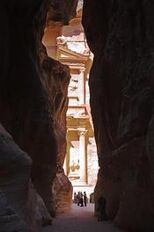
Al-Siq en rote to Al-Khazneh
Nabataean architecture is one of the most marvelled pre-Islamic architecture of the Arabs, most of it in their ancient capital Petra in Jordan. One of the focal points of Petra is Al-Khazneh (Arabic: الخزنة) or "The Treasury". Instead of building from the ground, the Nabataeans literally "carved" this temple and most of their structures into the sandstone rock wllhich is why Petra is dubbed the "Red Rose City" because of the rock's red colors. Al-Siq (Arabic: السيق) is a narrow entrance that leads to Al-Khazneh, that contains a huge dam.
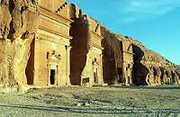
Rows of ancient Nabataean dwellings in Mada in Saleh in Saudi Arabia
Other sites in Petra include the Um Tomb, Al-Dier (The Monastery) which is in front of the Al-Khazneh temple. An even bigger temple lies in Petra, which is simply known as the Great Temple of Petra. Other hints of Greek influence include the installment of large theaters as one of the focal points of a city. Rows of ancient Nabataean dwellings can also be found in the city of Madeh in'Saleh in Saudi Arabia.
Mosques[]
The mosque, a Muslim house of worship or masjid (Arabic: مسجد) was an Islamic invention of the Arabs. Mosques saw the adoptation of domes and arches in Arab architecture
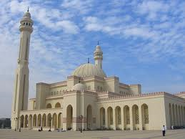
A mosque in Bahrain
. Ever since then, domes and arches have been absorbed into Arab architecture. A particular distinct type of arch used in Arabic-style structures are the horse-shoe arches. These type of arches were introduced and popularized during the Umayyad rule in the Levant and Iberia. Typical features of a mosque's interior contain the mihrab (Arabic: محراب) which is a niche in the wall. The mihrab directs Muslims of where to face during prayers (towards Mecca known as the qibla) known as the salat. The minbar (Arabic: منبر) is a pulpit in the mosque where imams or caliphs preach sermons. There is a tower known as the minaret (Arabic: مناره), which is where a person calls the en masse of people to prayer. The person calling those to prayer from a minaret is known as the muzzein (Arabic: مؤذن). The amount of minarets a mosque contains can usually vary from one to many, they are usually placed next or around the main building.
Holy Shrines[]
The three holiest cities to Muslims are Mecca and Medina in Saudi Arabia and Jerusalem in Israel.
Saudi Arabia[]
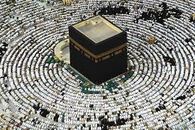
Each Muslim is obligated to make at least journey to the Kaaba in Mecca
The Masjid al-Haram is the world's biggest mosque, which is located in Mecca, Saudi Arabia. Mecca is the holy capital of the Muslim World and each Muslim is required to make at least one journey to this city, it houses the Kaaba (Arabic: بيت الحرام), a cuboid structure which Muslims believe to have been constructed by Abraham and Ishmael. Only Muslims are ever allowed in Mecca. About 4,000,000 Muslims visit Mecca each year on the holy month of Ramadan. The Masjid al-Haram is about 356,800 square meters and covers about eighty eight acres! The city of Medina is also in Saudi Arabia, this is Muhammad's birth place and is also home to Muhammad's grave. The grave is located to the Masjid al-Nabawi, the world's second largest mosque. The existances of these two mosques commonly gives Saudi Arabia the nickname "Place of the Two Sacred Mosques".
Israel and Palestinian territories[]
The third holiest city for Muslims is Jerusalem, shared by the two other monotheistic religions - Christianity and Judaism. It is referred to as Al-Quds (Arabic: القُدس) in Classical Arabic and Urshalim (Arabic: أُورُشَلِيمَ) in Standard Arabic. Arab architecture in Israel is also known as Palestinian architecture. Most of it can be found in East Jerusalem, where the majority of Jerusalem's Arab population resides. According to Islamic contexts, the Dome of the Rock (Arabic: مسجد قبة الصخرة) on the Temple Mount in Israel is where Muhammad allegedly ascended into Heaven as well as where Abraham nearly sacrificed his son Ishmael
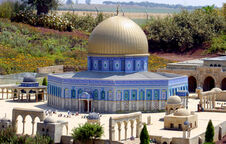
The Dome of the Rock in Jerusalem's Temple Mount is where Muhammad allegedly ascended
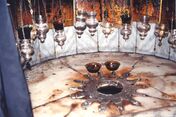
Church of the Nativity
. The Dome of the Rock, located in Temple Mount is a jewel of Palestinian architecture.. In the center is the rock where Muhammad was said to have ascended from and Abraham's near-sacrificing of Ishmael, surrounded by horse-shoe arches which is known as the Foundation Stone which also bears Jewish and Christian significance; it is the holiest site in Judaism. The Dome of the Rock was ordered into construction by the Umayyad caliph Abd al-Malik and also bears significant to Jews and Christians. Its Jewish origin as a temple is obvious (via its location on the Temple Mount on the remains of the previous two temples), but is also said to have been a Christian church prior to an Islamic structure, hinted by its Byzantine-style dome.[28] At one point during the Crusades, the Dome of the Rock was converted into a Christian church once the Christian crusaders laid siege to Jerusalem, before falling to Muslim armies Near the Dome of the Rock is the Al-Aqsa Mosque (Arabic: المسجد الأقصى), where the Islamic prophet Muhammad said to have first prayed upon his arrival to Jerusalem. Israel also contains some holy sites for the Israeli Druze. The Tomb of the Prophet Jethro in Hittin and Amin Tarif's tomb in Julis are famous pilgrimage sites for the Druze.
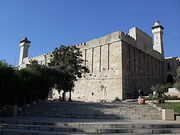
Southern view of the enclosure
The city of Bethlehem in Palestine contains the burials and tombs of the Biblical patriarchs, who are considered prophets in Islam and is regarded as Judaism's second-most holy city.The Cave of the Patriarchs or the Cave of Machpelah (Hebrew: מערת המכפלה) or the Sanctuary of Abraham (Arabic: حرم إبراهيم) is one of Hebron's most popular tourist attractions, a site that contains a fushion of Hebron's Jewish and Islamic era-influences. A Herod-era temple and a Saladin-era mosque are said to cover the caves which contain the burial sites of the Biblical patriarchs/matriarchs and the Islamic prophets. According to Jewish contexts, the site contains Abraham and Sarah, Isaac and Rebekah and Jacaob and Leah's burial sites. The site also contains a mosque, known as the Ibrahimi Mosque (Arabic: الحرم الإبراهيم) and contains the tomb of Joseph. The city of Bethlehem on the West Bank is also an attraction for Christian tourists. The Church of the Nativity (Arabic: كنيسة المهد, Latin: Ecclesia Nativitatis) which houses the place where Jesus Christ was born. A Silver Star marks the exact spot, or as claimed by Christians.
Syria and Yemen[]
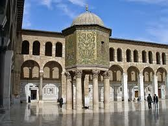
Umayyad Mosque
The city of Damascus in Syria is also significant to Muslims and Christians and became the capital of the Muslim World when the Umayyads conquered Syria, after having been a learning center of the Christian World. The Umayyad Mosque in Damascus is one of the world's largest mosques, and was formerly a church and converted to a mosque when the Umayyads ruled Syria and chose Damascus as their capital. The mosque functions as both a place of worship and a tourist destination. The city of Sana'a in Yemen is home to the some of the earliest and oldest "high rises", rising about 500 feet at the most. It also contains many other world UNESCO attractions such as The Rock Palace. Druze people are also native Syria, and it also contains many Druze shrines such as the Shrine of Christ and the Maqam Eyne El-Zaman.
Medieval Moorish Architecture[]
Southern Spain and Portugal are home to the jewels of medieval Moorish (mixed Arab-Berber), architecture and engineering even their languages
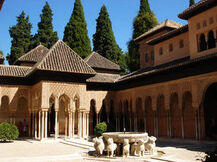
The Court of Lions at the Alhambra Palace in Granada, Spain
are so influenced by Arabic that many of their words are Arabic loanwords. The Great Mosque-Cathedral of Córdoba, a Catholic cathedral located in the Spanish city of Córdoba, remains an everlasting marvel of Islamic architecture and was once the world's second-largest mosque. It is most famous for its forest of arches that resemble the Dome of the Rock's and its elaborate art and calligraphy on the walls. It was built by the Umayyad Moors upon the remains of an old church and Pagan Roman temple as a mosque, and converted to a Catholic cathedral when the Christian armies reconquered Spain. Many elements of European architecture were added to the cathedral
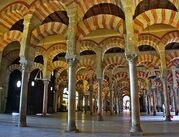
Forest of arches in the Mezquita de Córdoba
such as the choir room, but even Muslim travellers to Spain still praise the building's past as mosque. Muhammad Iqbal, a Pakistani poet who travelled to southern Spain in 1931. The famous Alhambra Palace (Arabic: الْحَمْرَاء) was built by Muhammad V, the sultan of Granada and Yusuf I, another prominent Muslim ruler at the time. It was built not only by the Umayyads, but other Muslim rulers as well and housed various Muslim royal families. It is most famous for many elements, such as its courtyard, which is referred to as the Court of the Lions which contains a fountain of a lions that spewed water out of each mouth, surrounded by horse-shoe arches. The main hall contains an elabrote ceiling that is commonly referred to as the "H
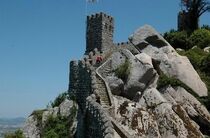
Castle of the Moors in Spain
oneycomb" because of its appearance. As the Europeans armies reconquered the Iberian Peninsula, the building retained its parlimental uses, housing Spanish royal families. Similar structures known as alcázars can be found scattered all over Andalucia, in cities like Seville and Málaga. In Portugal, there is the Castle of the Moors. The Castle of the Moors is a medieval fort built in hilltops. During the Reconquista, the Christian armies used it as a key point to retake the Iberian Peninsula. The castle is located in the Lisbon region, in the Sintra province, it is a national monument of Portugal.
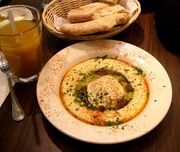
hummus
The Arab World contains a wide array of diverse foods and also absorbs influence from Turkish, Persian, Berber, and Indian cuisines. Lamb, chicken and beef are the top staple meats in the Arab countries as well as goat in the Horn of Africa. Staple vegetables include egg plants,

dolma
chickpeas, dates, tomatoes and onions. Staple grains and grain-products include wheat, lentils, pita bread and rice, almost all meals are served with a pita.
North African Cuisine[]
Kushari (Arabic: كشرى) is an Egyptian dish that is made of rice, lentils, chickpeas and macaroni with tomato sauce. Ful madame (Arabic: فول مدمّس) is a fava bean dish. It is also popular in the Levantine countries, and considered one of Egypt's national dishes. Asida (Arabic: عصيدة) is a dough-dish, though is resembles poridge that is popular in the North African and Maghrebi regions. In Libya, people traditionally eat it by using middle and index

falafel
fingers.
Arabian Cuisine[]
The cuisine of Yemen contains less dairy products and fish is also part of Yemeni cuisine. Seafoods are also part of the cuisines in Oman and Yemen since those nations contain coastal regions. The murtabak (Arabic: مطبق) is a folded food from Saudi Arabia that closely resembles pancakes. Murtabak's fillings generally vary from sweet pastes to meats and eggs.
Levantine Cuisine[]
Hummus (Arabic: حُمُّص) is a popular dip in the Levantine region that is made from mashed
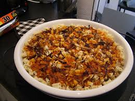
kushari
chickpeas, olive oil, garlic and sauce known as tahini (Arabic: طحينه). Tahini is made from ground sesame seeds, it is famous all across the Arab World, Israel and has become popular in western cuisines. Atayef bil ashta is a pancake-like food that is eaten mostly in Lebanon. The pancake is folded and filled with custards and other pastes. Falafel (Arabic: فلافل) is a deep-fried vegetable dish, which also another popular Levantine dish. Chickpeas and fava beans are mashed into balls and deep-fried, making the food appear to be meatballs - although it is an entirely vegetable dish. Like hummus, falafel is also very popular and is considered a national dish in Lebanon and Israel. Dolma is
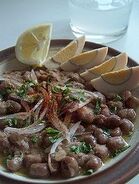
Ful Madame
another vegetable dish, which is usually stuffed and made from tomato, pepper, onion and zucchini.
Rice Dishes[]
Rice is also a central staple of Arab cuisine, mostly notabely basmati rice. Biryani (Urdu: بریانی), is a rice dish of Persian and Indian origin, that is popular typically in Iraq, having the most Persian influence of all the Arab countries. Biryani ingredients other than rice usually include meat, eggs, fish or vegetables. The Turkish rice dish known as pilaf is also popular in Arab countries and the Middle East, served in Arabic restaurants around the

Qatayef
world.
Desserts and Beverages[]
Baklava (Turkish: باقلوا), is a nut-flavored pastry. The pastry is made with layers of filo and is also eaten in many Eastern European countries that were former Ottoman territory. Coffee and tea are a central theme to Middle Eastern cuisine, coffee originated from the Arabian Peninsula. Ayran is a cold yogurt-based drink that is mixed with other ingredients such as salt. Ayran is also of Turkish influence. Because Syria is a secular state and Lebanon with its large Christian population, alcoholic drinks are common in both countries Qatayef (Arabic: قطايف) is a special dessert, a dumpling-like food filled with nut-flavored cream that is made during the Islamic holy month of Ramadan that originated from the Fatimid caliphate. During Ramadan, meals are eaten in a special way and desserts become sweeter, let alone the fact that Arabs already follow a particular style of eating.
Culinary Laws []
Islamic food laws are known as Halal (Arabic: حلال), which means "permissable" in Arabic. Halal laws forebid Muslims from eating swine meat (pork) or drinking alcohol, lest it be a sick or dying person in desperation. Therefore, pork is absent in Arab cuisine. Pork is also absent in the diet of all the people in the Arab World in general, including all Christians, Jews and non-religious since pork is not part of the Arab World's culinary history.
Notable Arabs or People of Arab Origin[]
|
Philip the Arab فيليب العربى |
Roman emperor from Syria, then the Roman province of Arabia Petraea who made peace with the Sassanid Empire upon Rome's millenial celebration - he was the 33rd Emperor "ceasar" of the Roman Empire, came from a prominent family known as the Baleed that is descended from an Arabian tribe that migrated from Yemen to Syria |
| Queen of Sheba ملكة سبأ |
An un-named monarch who ruled the Kingdom of Saba (Sheba according to Biblical sources) of some prominence who made the famous visit to King Solomon documented in Biblical sources. Her true ancestry and domain is in debate between historians from Yemen and Ethiopia. Arab and Islamic sources, which identify her name as Bilquis claims she was native South Arabian monarch while pan-African sources claim she was an Ethiopian. |
|
Zenobia الزباء |
A queen from Syria who led a successful empire that broke away from the Roman rulers, occupying the second largest kingdom in the region spanning the Levant and Asia Minor, she is either of Aramean, Arab or Jewish descent or a mix of all three, her linguisic history shows evidence pointing to all three groups |
| Julia Domna جوليا دومنا 
|
A member of the Severan dynasty of the Roman Empire. Empress and wife of Roman Emperor Lucius Septimius Severus and mother of Emperors Geta and Caracalla, Julia was famous for her prodigious learning as well as her extraordinary political influence. The greatest in a long line of women exercising power behind the throne in Rome, she was effectively the de facto ruler of an Empire of seventy million people stretching from Scotland to Iraq, born in Syria to a family thought to be of Arab descent |
| Elegabalus إلهجبال |
Roman Emperor from 218-222, a member of the Severan Dynasty, 25th emperor of the Roman Empire from the Severan Dynasty, his actual regnal and Latin name was Marcus Aurelius Antonius Augustus, and was known as Elegabalus after his death, which was the name of an ancient Syrian mountain god |
|
Ibn Shaddad عنترة بن شداد |
A hero, legend and poet from northern Arabia who was known for his romanticism and adventures, dubbed "Arab Romeo and Juliet", his poems are recorded in the Mu'allaqat, a collection of pre-Islamic poems from Arabia |
|
Muhammad محمد |
Known commonly as "Prophet Muhammad", a member from the Quraish tribe from Medina in Arabia who found the major religion of Islam and claimed to be a "completion" of God's line of messangers, and gave the birth to Arabic literature (as it exists in modern-days) - it is actually forebidden in Islam to ever view or make images of the prophet or any other Islamic prophet |
|
John of Damascus يوحنا الدمشقي |
A priest and monk from Syria who is one of the founding fathers of Eastern Christianity, multilingual in Arabic, Greek and other languages that defended the use of icons in Greek churches, known as the "Doctor of the Church", he is honored in many major churches including both Catholic and Orthodox sections |
|
Abd-ar-Rahman III عبد الرحمن الثالث |
The Ummayad Moorish ruler Córdoba, born to both Umayyad and Spanish nobilities who ruled for half a century, leading an influential reign marked by religious tolerance and became the most powerul Muslim ruler of Iberia, he ended up becoming one of Iberia's most powerful Muslim rulers |
| Al-Kindi الكندي |
A medieval mathematician, musician, and philospher from Iraq who adopted Greek and Hellenistic traditions into the Muslim and Arab World, known as the father of Arab philosophy, In the field of mathematics, al-Kindi played an important role in introducing Indian numerals to the Islamic and Christian world. He was a pioneer in cryptanalysis and devised several new methods of breaking ciphers |
| Alhazen الحسن |
Also known by his Arabic short name Ibn al-Haytham, a medieval scientist, polymath, mathematician, astronomer and philosopher from the Iraqi city of Basra who made significant contributions to the principles of optics, astronomy, mathematics, meteorology, visual perception and the scientific method. He has been described as the father of modern optics, ophthalmology, experimental physics and scientific methodology and the first theoretical physicist, he is regarded as the "Second Ptolemy" by Europeans |
|
Ibn Khaldun ابن خلدون |
A historian and historiographer from Tunisia, who is considered a founding father of modern-day economics, sociology and historiography and is appreciated by European historians as one of the greatest Muslim philosophers |
|
Al-Mutanabbi المتنبي |
A medieval poet from Iraq, considered one of the greatest poets of the Arabic language his poems oftenly praised the kings and rulers that he visited, known to be a very courageous and intelligent man through his poetry |
|
Ibn Rushd بن رشد |
Also known by his Spanish name Averroes, an Andalusian Muslim polymath, a master of Aristotelian philosophy, Islamic philosophy, Islamic theology, Maliki law and jurisprudence, logic, psychology, politics and Andalusian classical music theory, and the sciences of medicine, astronomy, geography, mathematics, physics and celestial mechanicshe has been described as the "founding father of secular thought in Western Europe" |
| Albucasis أبو القاسم |
An Andalusian physician. He is considered the greatest medieval surgeon to have appeared from the Islamic World, and has been described by many as the father of modern surgery. His greatest contribution to medicine is the Kitab al-Tasrif, a thirty-volume encyclopedia of medical practices. His pioneering contributions to the field of surgical procedures and instruments had an enormous impact in the East and West well into the modern period, where some of his discoveries are still applied in medicine to this day. His full name was Abu al-Qasim Khalaf ibn al-Abbas Al-Zahrawi. |
|
Hussein bin Ali حسين بن على |
An emir and sharif from Mecca who initiated the Arab Revolt against the Ottoman Empire and fueled Arab unification, he also became the king of the Kingdom of Hejaz, and after the Ottoman Empire's downfall in 1924, proclaimed himself ruler of the Islamic World |
| Michel Aflaq ميشيل عفلق |
A Syrian philosopher, sociologist and Arab nationalist. His ideas played a significant role in the development of Ba'athism (Arab nationalist) and its political movement; he is considered by several Ba'athists to be the principal founder of Ba'athist thought. |
|
Sultan Pasha al-Atrash سلطان باشا الأطرش |
Druze leader and Syrian nationalist who was an important leader of the Syrian Revolution who fought the Ottoman rulers, French colonists and oppressive regimes of the Syrian government, he also participated in the Arab Revolt in the Hejaz. He is one of Syria's most important figures, and of the Druze people. Statues of his can be found all over the Jabal el-Druze (Druze Mountains) in Syria. |
| Hafez al-Assad حافظ الأسد |
Syrian statesman, politician and general who was President of Syria from 1971 to 2000, Prime Minister from 1970 to 1971, Regional Secretary of the Regional Command of the Syrian Regional Branch and Secretary General of the National Command of the Ba'ath Party from 1971 to 2000. He took part in many coups, and brought the Ba'ath party to power in Syria. He led Syria's forces during the 1973 Yom Kippur War against Israel. His, Bashar al-Assad is the current leader of Syria. |
| Asmahan أسمهان |
A Syrian singer and actress who lived in Egypt for some time. Her's was the only female voice in Arab music to pose serious competition to that of Umm Kulthum of Egypt, who is considered to be one of the Arab world's most distinguished singers of the 20th century. She was the daughter of Sultan Pasha al-Atrash. |
|
Gamal Abdel-Nasser جمال عبد الناصر |
The second president of Egypt who is considered a political hero of the Arab World, eliminated imperialism in Egypt and Sudan and promoted Egyptian and Arab nationalism, he was most famous during Egypt's wars with Israel |
|
Umm Kulthum أم كلثوم |
An Egyptian singer who gave a rebirth to Arabic music and became the most famous and well-respected female singer in the music history of the Arab World, her songs are popular throughout the Arab World and was a national music pride of Egypt |
| Naguib Mahfouz نجيب محفوظ |
An Egyptian writer who won the 1988 Nobel Prize for Literature. He is regarded as one of the first contemporary writers of Arabic literature to explore themes of existentialism. He published 34 novels, over 350 short stories, dozens of movie scripts, and five plays over a 70-year career. Many of his works have been made into Egyptian and foreign films. |
| Ahmed Zewail أحمد زويل |
An Egyptian-American scientist, known as the "father of femtochemistry", he won the 1999 Nobel Prize in Chemistry for his work on femtochemistry and became the first Egyptian scientist to win a Nobel Prize in a scientific field. He is the Linus Pauling Chair Professor Chemistry, Professor of Physics and the director of the Physical Biology Centre for the Ultrafast Science and Technology at the California Institute of Technology. |
|
Muhammad Ahmad محمد أحمد |
A Sudanese religious leader from the Samaniyya order (of Islam), proclaimed himself as the Mahdi or messanic figure of Islam and hastened Sudanese nationalism and enmity against the Turkish rulers in Egypt and Sudan |
| Zeinab Badawi زينب بدوي |
A Sudanese-British television and radio journalist. She was the first presenter of the ITV Morning News (now known as ITV News at 5:30), and co-presented Channel 4 News with Jon Snow (1989–1998), before joining BBC News. Badawi is currently the presenter of World News Today broadcast on both BBC Four and BBC World News, and Reporters (BBC News programme), a weekly showcase of reports from the BBC. |
|
Mustafa Wahbi al-Tal مصطفى وهبي التل |
Better known as Arar, a Jordanian nationalist, poet, reformist, lawyer, teacher, judge, political agitator, philosopher and a major influencer in the Jordanian national and anti colonial movements. Arar was a pioneer of Jordanian patriotism and a spokesman for the nation's ideals and aspirations. |
|
Rania al-Abdullah رانيا العبد الله |
Current queen consort of Jordan, who is a leading influential-speaker on social issues of many fields, advocates global education and of education for Jordanian people - a philanthropist-like figure |
|
Al-Waleed bin Talal الوليد بن طلال |
A Saudi Arabian bussiness magnate, investor, and philantropist. He is the founder and majority owner of Kingdom Holding Co., a powerful investing company based in Riyadh, according to Forbes magazine in March 2013, he was ranked the 26th richest man in the world, in Arabian Bussiness he was considered the most influential Arab and in 2008 was part of Time 100 list of annual most influential people, he also holds many charitable activities for victims of natural disasters, war and poverty |
|
Ameera al-Taweel أميرة الطويل |
A Saudi Arabian princess, philanthropist, activist and international fashion icon who is well-known for her humanitarian efforts as well as for change in the social system in Saudi Arabia, women's rights to drive in Saudi Arabia and is the Vice Chairman of the non-profit charitable organization Alwaleed bin Talal Foundation and is also a member of the board of trustees at Silatech, an organization mean to create jobs for people in the Arab World. She is ranked as the fourth most powerful Arab woman |
|
Majed Abdullah ماجد عبد الله |
A former Saudi Arabian soccer (football) player who played as a striker for Saudi Arabia's national team, who was nicknamed Arabian Pelé (after the Brazilian player), he was voted as the best football player in the history of Saudi Arabia |
|
Zainab al-Khawaja زينب الخواجة |
A Bahraini humans rights activist, who was a very prominent member of the Bahraini Uprising, including the participation of many hunger strikes with her father, also led a cyber protest on Twitter |
|
Tawakkol Karman توكل كرمان |
A Yemeni journalist, politician and and member of the reformist Al-Islah party who became the face of the Yemeni Uprising of 2011, she won the Nobel Peace Prize in the same year becoming the only Arab woman to ever win the prize |
|
Tawfiq Canaan توفيق كنعان |
A medical researcher, ethnographer, doctor, physician and a Palestinian nationalist who has authored more than 37 health subjects in Palestine operating in several hospitals, he was also a mystical believer and in Palestinian folklore, collecting talismans of believed supernatural powers, he also worked as a doctor for the Ottomans |
|
Emile Habibi إميل حبيبي |
A Palestinian communist politician and author of Arabic expression, considered the 143rd greatest Israeli out of 200 great Israelis despite his criticisms of the State of Israel, his literature has become part of Israeli literature, he is one of the very few Arab Israelis to have recieved the Israel Prize, Israel's highest national honor |
| Yasser Arafat ياسر عرفات |
A Palestinian leader who was Chairman of the Palestine Liberation Organization (PLO), President of the Palestinian National Authority (PNA), and leader of the Fatah political party and former paramilitary group, which he founded in 1959. He spent much of his life fighting against Israel in the name of Palestinian self-determination and was involved in decades-long negotiations between Israel and the PLO. He is a widely revered figure in the Arab World and of the Palestinians. |
|
Amin Tarif أمين طريف |
The qadi (spiritual leader) and sheikh of the Israeli Druze from 1928 to 1993, he was awarded the Israel Prize in 1990 for his special contribution to Israeli society and is one of the few non-Jews that held this award, his tomb is now a pilgrimage site among Druze people |
|
Rana Raslan رسلان رنا |
An Israeli pageant from the Israeli city of Haifa, who was crowned Miss Israel in 1999 and was the first Arab to recieve the title, her reign as Miss Israel according to Israeli prime minister Benjamin Netanyahu was as "a feat of democracy in Israel", Israel is a Jewish state |
| Khalifa bin Zayed Al Nahyan خليفة بن زايد بن سلطان آل نهيان |
The president of the United Arab Emirates and Ruler of the Abu Dhabi Emirate. During his days as Crown Prince, he had effectively been acting president earlier since the late 1990s as his father was in ill health, being in his 80's. Khalifa is also chairman of Abu Dhabi Investment Authority. He is also a philanthropist. |
| Libna Khalid al-Qasimi لبنى خالد القاسمي |
The Minister for Foreign Trade and was previously Minister of Economic and Planning of the United Arab Emirates. Sheikha Lubna holds the distinction of being the first woman to hold a ministerial post in the United Arab Emirates. She is a member of the ruling family of the Emirate of Sharjah and the niece to His Highness Dr. Sheikh Sultan bin Mohamed Al-Qasimi. |
| Khalil Gibran جبران خليل جبران |
A Lebanese artist, poet, and writer. He is chiefly known in the English-speaking world for his 1923 book The Prophet, an early example of inspirational fiction including a series of philosophical essays written in poetic English prose. He is the third best-selling poet of all time, behind Shakespeare and Laozi |
|
Fairuz فيروز |
A Lebanese singer who is one of the most prolific, respected and prominent living singers of the Arab World, her songs are extremely popular throughout the entire Arab World and is a national music pride of Lebanon, often thought as the Lebanese counterpart to Umm Kulthum |
| Haifa Wehbe هيفا وهبي |
A Lebanese singer and actress, known through her music for her beauty, showmanship, sex appeal, provocative mannerisms and image, releasing four studio albums and made her acting debut in 2008 Pepsi-produced film Sea of Stars. In 2006, she was on People Magazine's 50 most beautiful people list. |
|
Faisal I of Iraq فيصل الاول من العراق |
Third son of Hussein bin Ali, who became the king of Syria and Iraq, a member of the Arab Revolt which strengthened unity, became temporary king of Syria and permanent king of Iraq |
| Al-Jawahiri الجواهري |
An Iraqi poet, he worked for a short period in the court of King Faisal I when he was crowned king of Iraq and when he was still wearing the turban of a cleric and participated in the 1920 revolution against the British authorities, at several times he was elected head of the union of Iraqi writers. |
| Naseer Shamma صير شمه |
A renowned Iraqi musician and oud player. He began studying the oud at the age of 12 in Baghdad, following in the footsteps of Jamil and Munir Bashir. He received his diploma from the Baghdad Academy of Music in 1987. He began to teach oud after three years at the academy, as well as continuing his own studies. Shamma has composed music for films, plays and television. |
| Fayeq Abdul-Jaleel فائق عبدالجليل |
Real name is Fayeq Mohammed Al-Ayadhi, a prominent Kuwaiti poet, playwright and lyricist whose work was well known throughout the Arab world. He was captured by Iraqi forces during the invasion of Kuwait in 1990 and he was the best known of more than 600 Kuwaiti civilians who were held as prisoners of war by Saddam Hussein's government. He was never seen by his family or friends again until his remains were unearthed in the Iraqi desert in 2004. |
| Omar Mukhtar عمر المختار |
A Libyan revolutionary who led a native resistance against the Italian colonization of Libya. A teacher of the Qur'an by profession, he was also skilled in the strategies and tactics of desert warfare. He knew local geography well and used that knowledge to advantage in battles against the Italians. |
|
Salah Mejri صالح الماجري |
A Tunisian professional basketball player who plays as a center for Real Madrid of the Spanish League, he also a member of the senior men's Tunisian national basketball team and helped win Tunisia a bronze medal in the FIBA Championship and was named the MVP of the 2011 FIBA Africa Championship |
|
Younes El Aynaoui يونس العيناوي |
A retired Moroccan tennis player who is a five-time singles winner Association of Tennis Professionals (ATP) Tour and was ranked No. 14 in the World at age 31 and is an extremely popular Moroccan national who received the gold medal from Mohammed VI, king of Morocco which is the highest honor |
| Hassan Hakmoun حسن حكمون |
A Moroccan American musician who specializes in the Gnawa style of music in Morocco, he was born to a family of musical background and his mother is a mystic healer, he has also composed for some American films such as Disney's Jungle 2 Jungle |
| Emir Abdelkader الأمير عبد القادر |
An Algerian religious and military leader who led a struggle against the French colonial invasion in the mid-19th century. An Islamic scholar and Sufi who unexpectedly found himself leading a military campaign, he built up a collection of Algerian tribesmen that for many years successfully held out against one of the most advanced armies in Europe. He also was known for promoting human rights, saving Christians from persecution, stopping a massacre against them in Damascus in 1860. |
| Ahmed Ben Bella أحمد بن بلّة |
An Algerian socialist soldier and revolutionary who was the first President of Algeria from 1963 to 1965, After stabilizing the country, he embarked on a series of popular but somewhat anarchic land reforms to the benefit of landless farmers, and increasingly turned to socialist rhetoric. He was also the president of the International Campaign Against Aggression on Iraq and Chairman of African Union Panel of the Wise |
| Cheb Mami شاب مامي |
Actual name is Ahmed Khelifati Mohamed, an Algerian raï singer. He sings and speaks in Algerian Arabic, and sometimes, as on Layali, in Egyptian Arabic. He is well-known throughout the Western World as the "Prince of Rai", for his duet performances with Sting. |
|
Ralph Nader رالف نادر |
An American politician and political activist that wrote the book Unsafe at Any Speed, paving the way for automobile safety laws in the United States - born to Lebanese parents in the United States, Arabic is his native language and has spoken it since his childhood |
|
Rima Fakih ريما فقيه |
A Lebanese-born American beauty pageant who won Miss U.S.A Title in 2010 and training to be a Diva in World Wrestling Entertainment, she is the first Arab American and Lebanese American to ever win the title, she also represented the state of Michigan (which contains the highest Arab American concentration) in the competition |
See Also[]
- Arab Christians
- Arab Israelis
- Palestinians
- Israelis
- Yemenites
- Yemenite Jews
- Mizrahi Jews
- Lebanese people
- Syrians
- Iraqis
- Somalis
- Berbers
Sources[]
- ↑ Margaret Kleffner Nydell Understanding Arabs: a guide for modern times, Intercultural Press, 2006, ISBN 1931930252
- ↑ Margaret Kleffner Nydell Understanding Arabs: a guide for modern times, Intercultural Press, 2006, ISBN 1931930252
- ↑ http://www.unesco.org/new/en/unesco/events/prizes-and-celebrations/celebrations/international-days/world-arabic-language-day/
- ↑ Data vary widely among sources: 1,300,000 Worldstatesmen.org(c. 2000); 2,000,000[1] (c. 2001); 3,500,000 Inmigración sirio-libanesa en Argentina (uncertain, but more recent date)
- ↑ http://books.google.ch/books?id=bJW79Rlu-igC&pg=PA1706&lpg=PA1706&dq=Arab+American+3,500,000&source=bl&ots=S4IPO11axq&sig=BIy5Cyrih1NA1uIK6k_tZt22BKo&hl=en&sa=X&ei=UzHBUc2hNYeGOI_cgOAG&ved=0CE0Q6AEwBA#v=onepage&q=Arab%20American%203%2C500%2C000&f=falseArab
- ↑ http://plus.lefigaro.fr/note/how-does-france-count-its-muslim-population-20110407-435643
- ↑ https://www.cia.gov/library/publications/the-world-factbook/geos/ir.html
- ↑ http://alwishahab.wordpress.com/2009/08/20/hadramaut-dan-para-kapiten-arab/
- ↑ http://www1.cbs.gov.il/publications13/yarhon0313/pdf/b1.pdf
- ↑ http://www.worldstatesmen.org/Mexico.htm
- ↑ http://www.saudiaramcoworld.com/error.htm?aspxerrorpath=/issue/200505/the.arabs.of.brazil.html
- ↑ "Toplumsal yapı araştırması 2006". KONDA Research and Consultancy. 2006. pp. 15–16. Retrieved May 10, 2012. (Turkish)
- ↑ "A2 : Population by ethnic group according to districts, 2012". Department of Census & Statistics, Sri Lanka
- ↑ https://joshuaproject.net/people_groups/14926/CD
- ↑ http://linguistics.byu.edu/classes/ling450ch/reports/arabic.html
- ↑ http://www.eretzyisroel.org/~jkatz/arabia.html
- ↑ http://fanack.com/countries/yemen/history/the-himyarite-kingdom
- ↑ http://www.jewishencyclopedia.com/articles/5159-dhu-nuwas-zur-ah-yusuf-ibn-tuban-as-ad-abi-karib
- ↑ P. Yule, Himyar Spätantike im Jemen, Late Antique Yemen, Aichwald, 2007, p. 98-99
- ↑ http://www.brown.edu/Departments/Joukowsky_Institute/Petra/excavations/history.html
- ↑ http://www.questtravelgroup.com/hl_sites_history/nabateans.htm
- ↑ http://en.wikipedia.org/wiki/Lakhmids
- ↑ http://en.wikipedia.org/wiki/Palmyrene_Empire
- ↑ http://islam.about.com/cs/divisions/f/shia_sunni.htm
- ↑ http://www.mliles.com/melkite/
- ↑ http://qifanabki.com/2009/10/15/maronites-arabs-phoenicians-klingons/
- ↑ "Religions in the Holy Land: Druze Faith" Stand for Israel. Retrieved 28-9-13
- ↑ October 1999"The Secret Key to the Dome of the Rock" Martin, Ernest L. Retrieved 17-9-2013]






















































